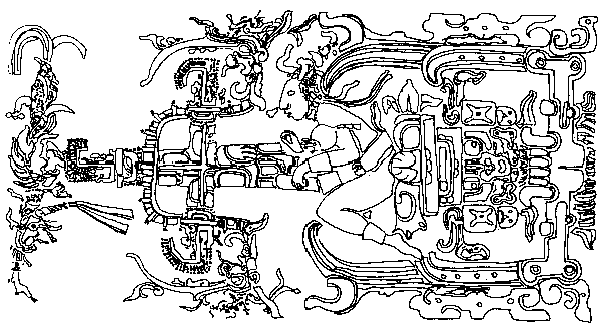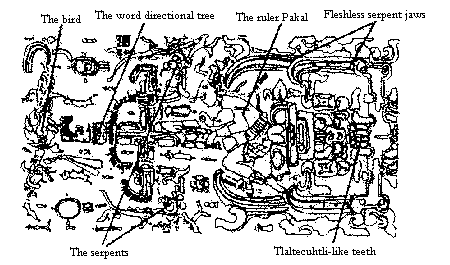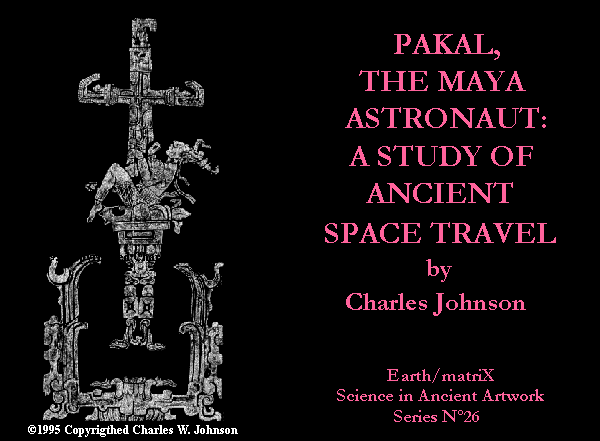|
|
Purchase/Download in Amazon
Sound of Meaning: Ancient Egyptian, Maya and Nahuatl
Author: Charles William Johnson
154 pages
ISBN 0.9755482-04
Price: $3.99 US

|
|
Purchase and download in Amazon
Comparative Linguistics of Ancient Egyptian Hieroghyphs
Author:
Charles William Johnson
ISBN 1-58616-434-1
PDF file
Copyrighted 2006
206 Pages
Price: $3.99 US

|
|
|
|
|
|
Earth/matriX
Science in Ancient Artwork
PAKAL, THE MAYA ASTRONAUT:
A STUDY OF ANCIENT SPACE TRAVEL
by Charles William Johnson
Introduction
In the Earth/matriX Series of essays, we
have been attempting to discern the manner in which the ancient astronomers/priests
seem to have translate astronomical data into mathematical models for
the reckoning of time. These mathematical models and the numerical data
related therein, then seem to have been interpreted into geometrical patterns
and designs. Finally, all of that appears to have found an expression
in the creative artwork of ancient cultures.
The mathematical models and the geometrical designs seem to allow for
distinct interpretations and manipulations of the artistically expressed
sculptures. By identifying the linear coordinates and the spatial logic
of some of the ancient sculptures, it would appear that a wealth of ideas
has been encoded into artwork. The possibility may exist, in fact, of
decoding those mathematical models and geometrical designs in order to
observe exactly what the artist (or astronomer/priest) was attempting
to communicate. In a certain sense, we have already seen some examples
of this in some of the previous essays of the Earth/matriX Series. Numbers
are rendered into specific geometrical coordinates and spatial designs
of the artwork. The Aztec Calendar has been a case in point.
Throughout the Earth/matriX Series, we shall attempt to identify distinct
sculptures and forms of artwork from ancient cultures that appear the
enclose a specific guide for manipulating the information encode in them.
The descipherment of the ancient artwork has been carried out through
attempts to read the glyphs that are generally found on the relief sculptures
of the ancient maya culture, for example. Yet, the fact that these sculptures
reflect a wealth of visual elements might also suggest that we should
be looking at those visual images as well; their compositional make-up,
for example. In our studies we attempt to related what is known about
the ancient reckoning systems and the numbers related to those systems,
with respect to the visual images portrayed in the sculptures and artwork.
We are not simply attempting to discern whether the accompanying glyphs
tell us who or what the sculpture is about, but rather what might the
images itself be suggesting in the way of original communication of ideas.
One particular sculpture that has captured the imagination of so many
of us been that of Pakal, the image of a maya ruler sculpted
on the lid of a stone sarcophagus deep within the Temple of Inscriptions
pyramid situated at the site of Palenque, Mexico.
PAKAL: THE MAYA ASTRONAUT

© 1995-2011 Copyrighted by Charles William Johnson
In 1949, the Mexican archaeologist Alberto
Ruz discovered a vaulted room beneath the floor of the Temple of Inscriptions,
in which he also discovered this large sarcophagus. The most incredible
reproduction of the images on this particular sarcophagus have been made
by professor Marle Greene Roberston, through rubbings on rice paper.
The human figure portrayed in relief on that stone slab has become known
as "the astronaut" to some; as "Pakal", a maya ruler, to others. From
the glyphs one may view the subject as Pakal; from the visual theme one
may see something that looks like a spacecraft within which he is seated.
Pakal appears to be seated at a control panel within a housing device,
very similar to today's space capsules. This relief sculpture has been
dated at around 690 our era, when there were apparently no space vehicles
in existence; that we know of anyway. Pakal's posture and positioning
appear to reflect the concept of movement, with his body leaning slightly
forward, as though he were travelling towards a specific point, in a particular
direction. Hugh Harleston, Jr., in 1974, produced a very vivid image and
detailed analysis of the possibility for interpreting Pakal's housing
device to represent a spacecraft. We should like to further that analysis
by adding the concept of movement to the interpretation.
Classical maya studies reveal an interpretation of this sculpture
that identifies its elements to represent the world-directional tree symbolized
by the cross, while the housing portrays the idea of the fleshless jaws
of an earth-serpent
PAKAL: THE CLASSIC INTERPRETATION

© 1995-2011 Copyrighted by Charles William Johnson
If we visualize the concept of movement
suggested in the sculpture, a very distinct possibility of interpretation
appears. Pakal's forward leaning position would seem to suggest that of
someone travelling at a fast speed, as we know it today. From the perspective
of the possibility of movement, we shall analyze the image from the viewpoint
of mechanics and engineering. In order to achieve this, we must break
down the parts of the image and consider the possible movement of each
particular section. By doing this, we shall observe how this stone slab
of possibility more than 1300 years old, may actually be registering an
event of space travel, long before we ever thought it to be possible on
Earth; or even in the Universe.
Today, we feverishly search the sky for some sign or trace of visitors
from outer space; we fervently analyze the crop circles in the wheat fields
of England for possible evidence of their visiting us now. We might have
to examine the historical record with a little more persistence in order
to see that the ancestors of the Earth, those who have gone before us,
may possibly have documented just such an experience already. The maya
artwork of the Temple of Inscriptions may just be that example of
historical documentation.
© 1995-2018 Copyrighted by Charles William Johnson
 |
BOOK
PAKAL: THE ANCIENT ASTRONAUT
In the book Pakal, the Ancient Astronaut, we explore the design
elements of the Pakal sculpture found at Palenque, Mexico. We have analyzed
and illustrated the design elements of the Pakal sculpture from the perspective
of simple mechanics. We have given movement to the elements within the
sculpture's image and in that manner see appear something that resembles
a space craft. Obviously, such a rendering of the sculpture may be viewed
critically, since from our knowledge about history, there is nothing in
the historical record about the existence of spacecraft; at least, nothing
specifically identified as such. However, in the visual rendering of Pakal's
vehicle, a geometrical analysis seems to offer more of a solution to the
enigma, than a semantic rendering of ancient texts.
Purchase and download in Amazon
ISBN 1-58616-189-X PDF file,
15MB 1993-1999
Copyrighted material 84 pages
Price: $4.99 US

|
Pakal: The Maya Astronaut

|

